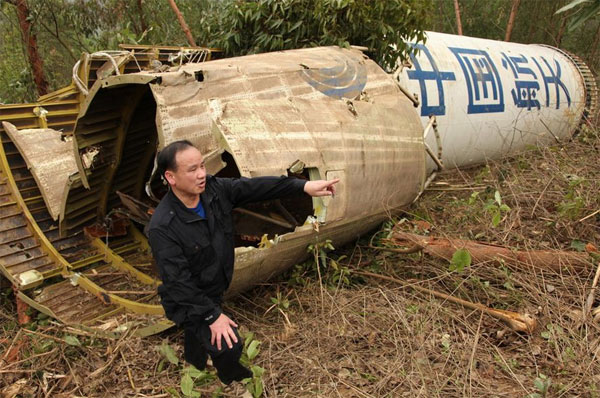Why don't more people get hit by falling space debris?
为什么被坠落的太空碎片击中的人并没有想象的那么多?
THE GOOD NEWS IS THAT YOU DIDN'T GET clobbered by China's Tiangong-1 space station when it fell to Earth on April 1.
好消息是,4月1日中国的天宫一号空间站坠落地球时没有砸到你。
The not-so-good news is that there's a lot more space junk where that came from.
不太好的消息是,像天宫一号那样的太空垃圾还有很多。
All the same, you can take off your hard hat, because your odds of getting conked are vanishingly small.
尽管如此,你还是可以摘下你的安全帽,因为你被击中的几率微乎其微。
At any moment, there are more than 500,000 pieces of space debris orbiting Earth.
任何时候,都有超过50万个太空碎片在绕地球运行。
Some are no bigger than a millimeter or two;
有些不超过一两毫米;
others—like Tiangong-1, which was the size of a school bus—are a potential menace.
其他的,比如校车大小的天宫一号,则有着潜在的威胁。
Left to themselves, the majority of satellites eventually tumble out of orbit.
如果任其发展,大多数卫星最终都会脱离轨道。
The principal cause is drag from the faint wisps of atmosphere that reach into what we consider the vacuum of space.
主要的原因是渗入我们所谓的“真空”的太空的几缕空气对那些物体的拉力。
The lower a spacecraft orbits, the more it feels these atmospheric fingers
航天器轨道越低,就越能感觉到这些“大气之手”的拉力,
and the less far it has to fall in the first place before beginning its final, laming dive.
在开始最后一段晃晃悠悠的俯冲之前,它最初要坠落的距离就越短。
Making things worse, the atmosphere subtly expands and contracts in response to solar activity.
更糟糕的是,大气层会随着太阳活动进行微妙的膨胀和收缩。
The drag it exerts on any orbiting spacecraft can thus unpredictably increase or decrease,
它对任何轨道航天器施加的阻力就会因此增大或缩小,但具体并不能预测,
making it hard for NASA or other agencies to predict precisely where the spacecraft will land.
这就使得NASA或其他机构难以准确地预测航天器的降落位置。
Worse, derelict spacecraft often tumble,
更加糟糕的是,废弃的航天器经常翻转,
causing the face— and thus the surface area—they present to the atmosphere
因而它们面向大气层的表面,以及相应的整个表面区域
to change constantly, adding one more X factor to the trajectory equation.
会频繁地改变,这样就又给轨道方程增加了一个未知因子。

One of the reasons none of this typically presents a danger is that when satellites reach the end of their useful lives,
但这些因素通常并不会带来危险,原因之一在于卫星的有效寿命接近尾声时,
they can be deorbited in a controlled way, sent on suicide dives to the middle of the ocean.
人们可以控制它们脱离轨道的方式,将它们以自杀式飞扑的方式送入茫茫大海。
It's when something goes wrong—when communications are lost or thruster fuel is exhausted—that re-entry becomes a crapshoot.
出现问题————通讯中断或推进器燃料耗尽——的时候,重返大气层能不能成功就要看运气了。
That's what happened when NASA's Skylab space station tumbled to Earth in 1979, and it's what happened with Tiangong-1 too.
1979年,NASA的“太空实验室”空间站坠落和这次“天宫一号”的坠落就是例子。
Even in those situations, the odds are very much on safety's side.
但即使在这样的情况下,安全坠落的可能性也还是更大。
Roughly 70% of Earth's surface is water, and much of its landmass is unpopulated.
因为大约70%的地球表面都是水,而即便是陆地,也还是有很多地方是无人居住的。
Some of Skylab's debris did rain down on land, but in a sparsely populated desert.
所以,尽管“太空实验室”是有一些碎片降落在了陆地上,但还是落在了人烟稀少的沙漠里。
The little town of Esperance, Australia, got some debris to exhibit in its local museum—
澳大利亚小镇埃斯佩兰斯在当地博物馆展出了一些太空垃圾的残骸,
along with a display of the $400 check it received in payment of a (mostly) playful highway-littering fine it imposed on the U.S.—but no one was injured.
还有一张小镇收到的400美元的支票,那是他们以美方在他们的高速公路上乱扔垃圾,堪称(最)调皮的扔垃圾了——好在没人受伤——为由给美国开的罚单。
If you're still worried, take comfort in some numbers:
如果你还是担心太空垃圾会砸到你,下面这些数字应该能让你安心不少:
in the long history of spaceflight, only one person has ever gotten on the wrong side of a piece of falling space junk.
在漫长的航天历史中,只有一个人在太空垃圾坠落的时候站在了错误的一边。
That was Lottie Williams of Tulsa, Okla., who was struck on the shoulder by a piece of a Delta II rocket in 1997.
这个人就是俄克拉荷马州塔尔萨的洛特·威廉姆斯。1997年,一枚德尔塔II型火箭的碎片击中了她的肩膀。
She was unhurt.
但她还是没有受伤。
According to the Aerospace Corp., a nonprofit group that tracked Tiangong-1's fall,
据追踪天宫一号下落的非营利组织“航空航天”公司称,
the likelihood of an individual being hit by space debris is less than 1 in 1 trillion.
一个人被太空碎片击中的可能性不到1万亿分之一。
The European Space Agency pegs the odds even longer.
欧洲航天局认为的可能性更小,
It says getting struck by lightning is 10 million times as likely as the 1-in-300 trillion odds of being hit by space debris.
声称被闪电击中的可能性是被太空碎片击中的1/300万亿的几率的1000万倍。
译文由可可原创,仅供学习交流使用,未经许可请勿转载。



